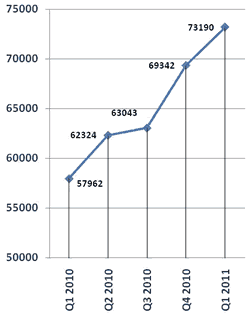PandaLabs, Panda Security’s anti-malware laboratory, has found that the number of threats in circulation has risen, reporting a 26 percent increase in new threats compared to the same period last year.
 In the first three months of 2011, PandaLabs said it had identified an average of 73,000 new malware strains each day, most being Trojans. And we are only halfway through March. In 2010 PandaLabs said it saw an average of approximately 63,000 new threats each day.
In the first three months of 2011, PandaLabs said it had identified an average of 73,000 new malware strains each day, most being Trojans. And we are only halfway through March. In 2010 PandaLabs said it saw an average of approximately 63,000 new threats each day.
Overall, Trojans remain the most popular type of threat to computer systems, and now account for 70 percent of all new malware. Trojans, such as the popular ZeuS Trojan, have prooven to be incredibly lucrative for cybercriminals to commit fraud or steal money from Internet users through the online banking channel.
“The proliferation of online tools that enable non-technical people to create Trojans in minutes and quickly set up illegal business – especially when it provides access to banking details – is responsible for Trojans’ impressive growth,” said Luis Corrons, technical director of PandaLabs.
Not all kind of Trojans grow at the same pace, according to PandaLabs. When investigating the subtypes of malware, PandaLabs found that Banker Trojans have decreased, bots have remained steady, and fake anti-virus or rogueware has decreased in popularity. However, the number of “downloaders” has increased significantly. Downloaders are a subtype of Trojan that, once it has infected a user’s computer, connect through the Internet to download additional malware. Hackers often use this method because the downloader is lightweight – only containing a few lines of code – and can go completely unnoticed unlike other Trojans.
















